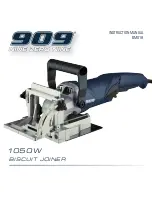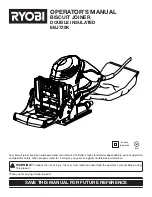
5
g) If devices are provided for the connection of dust
extraction and collection facilities, ensure these are
connected and properly used.
Use of dust collection
can reduce dust-related hazards.
4) Power tool use and care
a) Do not force the power tool. Use the correct power
tool for your application.
The correct power tool will
do the job better and safer at the rate for which it was
designed.
b) Do not use the power tool if the switch does not turn
it on and off.
Any power tool that cannot be controlled
with the switch is dangerous and must be repaired.
c) Disconnect the plug from the power source and/or
the battery pack from the power tool before making
any adjustments, changing accessories, or storing
power tools.
Such preventive safety measures reduce
the risk of starting the power tool accidentally.
d) Store idle power tools out of the reach of children
and do not allow persons unfamiliar with the power
tool or these instructions to operate the power tool.
Power tools are dangerous in the hands of untrained users.
e) Maintain power tools. Check for misalignment or
binding of moving parts, breakage of parts and any
other condition that may affect the power tool’s
operation. If damaged, have the power tool repaired
before use.
Many accidents are caused by poorly
maintained power tools.
f ) Keep cutting tools sharp and clean.
Properly
maintained cutting tools with sharp cutting edges are
less likely to bind and are easier to control.
g) Use the power tool, accessories and tool bits etc.
in accordance with these instructions, taking into
account the working conditions and the work to be
performed.
Use of the power tool for operations different
from those intended could result in a hazardous situation.
h) This appliance is not intended for use by persons
(including children) with reduced physical, sensory
or mental capabilities, or lack of experience and
knowledge,
unless they have been given supervision or
instruction concerning use of the appliance by a person
responsible for their safety.
i) Children should be supervised to ensure that they do
not play with the appliance.
5) Service
a) Have your power tool serviced by a qualified repair
person using only identical replacement parts.
This
will ensure that the safety of the power tool is maintained.
Additional safety rules for biscuit joiners
•
Hold tool by insulated gripping surfaces when performing
an operation where the cutting tools may contact hidden
wiring or its own cord. Contact with a “live” wire will make
exposed metal parts of the tool “live” and shock the
operator.
•
Fully unwind cable drum extensions to avoid potential
overheating.
•
When an extension cable is required, you must ensure
that it has the right ampere rating for your power tool
and is in safe electrical condition.
•
Ensure your mains supply voltage is the same as your
tool rating plate voltage.
•
If possible, always use clamps or a vice to hold your work.
•
Always switch off before you put the biscuit joiner down.
•
Ensure that the lighting is adequate.
•
Keep the area free of tripping hazards.
•
Do not let anyone under 18 years operate this tool.
•
Only use accessory blades that are in good condition.
•
Do not touch the blade after operation. It will be hot.
•
Keep yours hands away from under the workpiece.
•
Never use your hands to remove chips or waste close by
the blade.
•
Rags, cloths, cord, string and the like should never be left
around the work area.
•
Support the work properly.

















